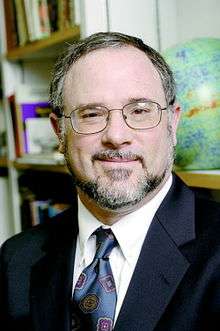Charles L. Bennett

Charles L. Bennett (born November 1956) is an American observational astrophysicist. He is a Bloomberg Distinguished Professor, the Alumni Centennial Professor of Physics and Astronomy and a Gilman Scholar at Johns Hopkins University.[1] He is the Principal Investigator of NASA's highly successful Wilkinson Microwave Anisotropy Probe (WMAP).[1]
His National Academy of Sciences (NAS) membership citation states, "As leader of the Wilkinson Microwave Anisotropy Probe (WMAP) mission, Bennett has helped quantify, with unprecedented precision and accuracy, many key properties of the universe, including its age, the dark and baryonic matter content, the cosmological constant, and the Hubble constant."[2] Membership is a great honor bestowed upon the most distinguished scholars in engineering and the sciences.[3] He was awarded the National Academy of Sciences Henry Draper Medal in 2005 [4] and the Comstock Prize in Physics in 2009,[5] both for his leadership of WMAP. Bennett received the Harvey Prize in 2006 for, "the precise determination of the age, composition and curvature of the universe."[6] Bennett shared the 2010 Shaw Prize in astronomy with Lyman A. Page,Jr. and David N. Spergel, both of Princeton University, for their work on WMAP.[7] The 2012 Gruber Cosmology Prize was awarded to "Charles L. Bennett and the WMAP Team" for "transforming our current paradigm of structure formation from appealing scenario into precise science." "By observing the relic radiation from the early universe, Charles L. Bennett and the WMAP team established the Standard Cosmological Model."[8] Bennett was named the 2013 Karl G. Jansky Prize Lecturer. [9] In 2015 Bennett was awarded the Caterina Tomassoni and Felice Pietro Chisesi Prize "For Dr. Bennett's leadership in two experiments on the Cosmic Microwave Background that literally changed our view of the Universe: COBE-DMR, leading to the discovery of primordial spatial fluctuations in the CMB, and WMAP, leading to precise measurements of the cosmological parameters and establishing -de facto- the Standard Cosmological Model".[10]
Bennett is a Fellow of both the American Association for the Advancement of Science and the American Physical Society.[1] In 2002, ISI named him the most Highly Cited Researcher in space science worldwide.[1] He is an author of the top two "Super Hot Papers in Science" published since 2003.[11] In 2004, he was elected a Fellow of the American Academy of Arts and Sciences.[12]
Before leading WMAP, Bennett was the Deputy Principal Investigator for the Differential Microwave Radiometers (DMR) instrument on the Cosmic Background Explorer (COBE) mission that discovered the anisotropy of the cosmic microwave background radiation. Bennett led the effort to rebuild the radiometer front-end microwave components that succeeded in significantly enhancing the sensitivity of the DMR instrument. The Cosmic Background Explorer (COBE) Science Team also precisely measured the spectrum of the cosmic microwave background radiation.
Prior to 2005, Bennett was a Senior Scientist for Experimental Cosmology, Goddard Senior Fellow, and Infrared Astrophysics Branch Head at the NASA Goddard Space Flight Center.[1] Bennett was at the Carnegie Institution of Washington's Department of Terrestrial Magnetism during the summers from 1976 to 1978.[1]
Awards
Bennett's awards include:[1]
- 2015 Caterina Tomassoni and Felice Pietro Chisesi Prize (Tomassoni awards)
- 2013 Karl G. Jansky Prize Lecturer
- 2012 Gruber Cosmology Prize (awarded to Charles L. Bennett and the WMAP Team "for their exquisite measurements of anisotropies in the relic radiation from the Big Bang---the Cosmic Microwave Background." "So precise are these findings that WMAP’s version of the universe is now commonly known as the Standard Cosmological Model."
- 2010 Shaw Prize in Astronomy
- 2009 Comstock Prize in Physics of the National Academy of Sciences
- 2006 The Harvey Prize of the Technion
- 2006 Gruber Cosmology Prize (awarded to John Mather and the COBE Team for "ground-breaking studies confirming that our universe was born in a hot Big Bang.")[13]
- 2005 Draper Medal of the National Academy of Sciences
- 2005 Rotary National Award for Space Achievement (Mid-Career Stellar Award)
- 2004 NASA Exceptional Scientific Achievement Award (for WMAP)
- 2003 NASA Outstanding Leadership Award (for WMAP)
- 2003 John C. Lindsay Memorial Award for Space Science
- 2001 Popular Science “Best of What’s New” Award in Aviation and Space for WMAP
- 1992 NASA Exceptional Scientific Achievement Medal (for COBE)
Education
Bennett received his B.S. from University of Maryland, College Park in physics and astronomy cum laude with High Honors in astronomy, which is part of the University of Maryland College of Computer, Mathematical, and Natural Sciences.[1]
1984 Ph.D. in Physics from the Massachusetts Institute of Technology[1]
Bibliography
- Wilkinson Microwave Anisotrophy Probe Charles L. Bennett Scholarpedia, 2(10):4731. doi:10.4249/scholarpedia.4731
References
- 1 2 3 4 5 6 7 8 9 "Brief Biography of Charles L. Bennett". Johns Hopkins University. Retrieved 13 February 2011.
- ↑ "Charles L. Bennett, Johns Hopkins University". National Academy of Sciences. Retrieved 13 February 2011.
- ↑ "National Academies members". National Academies. Retrieved 13 February 2011.
- ↑ "Henry Draper Medal". National Academy of Sciences. Archived from the original on 26 January 2013. Retrieved 13 February 2011.
- ↑ "Comstock Prize in Physics". National Academy of Sciences. Retrieved 13 February 2011.
- ↑ "Harvey Prize Winners". Technion – Israel Institute of Technology. Retrieved 28 July 2015.
- ↑ "Announcement and Citation - Astronomy - 2010". Shaw Prize. Retrieved 13 February 2011.
- ↑ "2012 Gruber Cosmology Prize Press Release". The Gruber Foundation. Retrieved 28 July 2015.
- ↑ "Jansky Prize". National Radio Astronomy Observatory. Retrieved 28 July 2015.
- ↑ "Tommasoni Prizes". Retrieved 28 July 2015.
- ↑ "Super Hot Papers in Science Published Since 2003". The Thomson Corporation. Retrieved 28 July 2015.
- ↑ "Book of Members, 1780–2010: Chapter B" (PDF). American Academy of Arts and Sciences. Retrieved June 15, 2011.
- ↑ "NASA and COBE Scientists Win Top Cosmology Prize". NASA. Retrieved 28 July 2015.
External links
- http://physics-astronomy.jhu.edu/directory/charles-l-bennett/
- http://www.nasonline.org/member-directory/members/20009960.html
- https://web.archive.org/web/20060901225010/http://cosmos.pha.jhu.edu/bennett/bio.htm
- http://map.gsfc.nasa.gov/
- http://www.aaas.org/aboutaaas/fellows/
- https://web.archive.org/web/20030224140830/http://www.aps.org:80/fellowship/1999/